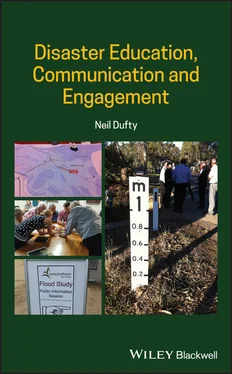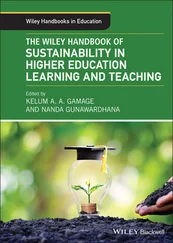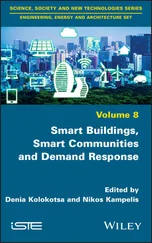Furthermore, appreciation of the input of at-risk people in disaster risk has broadened the scope of risk communication. As a result, communicative activities that place responsibility for preparedness actions in the hands of citizens are gaining relevance (Begg et al. 2016). With this in mind, four approaches of risk communication can be distinguished related to the one-way and two-way communication dimensions (Terpstra et al. 2017).
1 Risk message approach. This type of risk communication is a one-way flow of information from an expert source so that it is received in a consistent and accurate manner. For example, details of flood risk can be communicated by a risk map which provides clear details of flood extent to all.
2 Risk dialogue approach. In this two-way risk dialogue approach, the distinction between risk experts and the at-risk public is a blur. Here, participation allows for the inclusion of local knowledge from the at-risk public that can improve the quality of risk assessments and risk maps, as well as of the management process itself.
3 Risk government approach. Communication within the one-way risk government approach aims at changing attitudes and behaviours. This is done by authorities creating awareness of people's hazard risks and the consequences that related decisions might have on their lives.
4 Instrumentalist risk approach. This two-way approach aims at actively changing people's behaviour and pays close attention to the ‘interactions between information, attitudes, and behaviour’ (Demeritt and Nobert 2014). Underlying the instrumentalist risk approach, many empirical studies focus on understanding the factors that motivate individuals to take responsibility and action in order to increase their disaster preparedness (Shreve et al. 2014).
2.2.2 Crisis Communication
Crisis communication relates to communication as an emergency or disaster event unfolds, and as part of recovery from that event. However, Steelman and McCaffrey (2013) contend that crisis communication and risk communication should be merged in a more holistic, event-based approach. Their rationale ‘is that large-scale shifts in management response likely need to be communicated before as well as during an event, as effective outcomes may be dependent on how the communication in one period influences another’.
Crisis communication has its roots in crisis management and public relations (Williams and Olaniran 1998) and traditionally focused on the message and how it is delivered during and after the event.
The primary aim of an early warning system is to provide people with enough time to make themselves safe when a threat to them is imminent. A secondary aim is the protection of property. It is also important to try to ensure the safety of companion animals and livestock such as sheep, cattle, and horses.
According to Mileti and Sorensen (1990), ‘a warning system is a means of getting information about an impending emergency, communicating that information to those who need it, and facilitating good decisions and timely response by people in danger’.
Early warning is the bridge between risk and crisis communication. ‘Early warning is not only the production of technically accurate warnings but also a system that requires an understanding of risk and a link between producers and consumers of warning information, with the ultimate goal of triggering action to prevent or mitigate a disaster’ (International Federation of Red Cross and Red Crescent Societies 2009).
Clear, timely, and accurate warning information should be communicated to at-risk communities. The International Federation of Red Cross and Red Crescent Societies (2014a) states that ‘the outputs of an early warning system must recognise the diversity of the audience and be appropriate to that audience. Outputs should be contextualised, granular and specific to potentially impacted localities. They should include clear explanations of degree or severity, of trend, of timing, and of the confidence associated with the prediction. The choice of the language and the medium of the communication should be appropriate to the audience, as should the level of technical complexity.’
An early warning system, where at-risk communities, emergency agencies, and other parties (e.g. the media) share information through two-way communication, helps build trust and ensure appropriate responses as the emergency or disaster event unfolds. ‘A local, “bottom-up” approach to early warning, with the active participation of local communities, enables a multi-dimensional response to problems and needs. In this way, local communities, civic groups and traditional structures can contribute to the reduction of vulnerability and to the strengthening of local capacities’ (International Strategy for Disaster Reduction 2006).
After the immediate impact of a hazard event, there are multiple groups requiring information including those impacted (e.g. information about evacuation centres, loved ones such as family), those that could become at risk (e.g. drive into a flooded area), and those not impacted wishing to obtain news of the event. According to Wein et al. (2016), ‘messages need to be designed for a range of population preferences for type of information, mindful of various psychological states that affect how such information is processed, retained, and acted upon’.
During a disaster, individuals turn to a large diversity of information sources as they try to decrease their uncertainty and determine which actions to take (Hodgson 2007). Several studies have found indications that those who feel more at risk seek information more actively than those at less risk. In response to chaotic and uncertain conditions, evacuated members of the public more actively and aggressively search for information and can at times be more critical of the information they find (McCaffrey et al. 2013). Spence et al. (2007) found differences in the information desired and information-seeking behaviour of the disabled and non-disabled.
As for risk communication, trust appears critical during an emergency or disaster. A key element that may shape receiver response to an information source is how useful or trustworthy that source is seen to be. The receiver must have confidence not only in the content of the message itself, but also in the source. Key characteristics related to information delivered during a crisis event include crafting honest, trustworthy messages and leveraging credible sources (Seeger 2006).
Communication after a disaster is critical to ensure a speedy community recovery and reconstruction. In the early phases of recovery, this communication can be conducted by humanitarian organisations, as there is a tendency for media sources to move on to the next newsworthy event.
According to Hannides (2015), ‘in recent years, aid agencies have placed more emphasis on the need for information and communication in crisis, influenced by advances in technology that have dramatically increased the reach and potential of information, and by learning from the humanitarian failure that results from a lack of information and communication’.
There are two distinct, but related types of recovery crisis communication:
1 Communication that seeks to improve the humanitarian aid response.
2 Information and communication that seeks to meet the direct needs of people affected by crisis (usually involving some form of media intervention).
Communications that take place during acute crises can be different from the ones that occur during long-term reconstruction (Government of Australia 2014).
During acute crises, communication practices require a rapid gathering, verification, and distribution of information to multiple social groups about what actions have to be taken in order to reduce risk; on the other hand, long-term communication initiatives are typically developed in a context with lower risk and tend to convey messages aimed at social and behavioural change, policy reform, capacity building, and promotion of accountability and feedback mechanisms. During disaster recovery, more time is allowed to single out vulnerable social groups and identify information and communication needs for each of these and target actions accordingly.
Читать дальше












